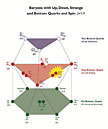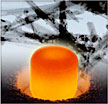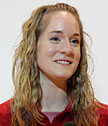- Number 344 |
- August 22, 2011
-
Fermilab experiment discovers a heavy relative of the neutron
 Scientists of the CDF collaboration at DOE’s Fermi National Accelerator Laboratory have discovered a new particle, the neutral Xi-sub-b. The particle is the latest entry in the periodic table of baryons, and the finding strengthens our understanding of how quarks form matter.
Scientists of the CDF collaboration at DOE’s Fermi National Accelerator Laboratory have discovered a new particle, the neutral Xi-sub-b. The particle is the latest entry in the periodic table of baryons, and the finding strengthens our understanding of how quarks form matter.
Baryons are particles formed of three quarks, the most common examples being the proton and the neutron. The neutral Xi-sub-b contains a strange quark, an up quark and a bottom quark. It is about six times heavier than the proton and neutron. The particle is produced only in high-energy collisions and very difficult to observe. Once produced, the neutral Xi-sub-b travels only a fraction of a millimeter before it decays into lighter particles. -
Industrial-scale carbon storage runs to ground
 Understanding how carbon dioxide can be stored underground is crucial for the progression of industrial-scale carbon sequestration. Such research is thriving internationally, and the role of DOE's Idaho National Laboratory in the carbon sequestration arena is growing both domestically and abroad.
Understanding how carbon dioxide can be stored underground is crucial for the progression of industrial-scale carbon sequestration. Such research is thriving internationally, and the role of DOE's Idaho National Laboratory in the carbon sequestration arena is growing both domestically and abroad.
-
Consortium to evaluate impacts of shale gas production using hydraulic fracturing
 DOE’s National Energy Technology Laboratory is leading a consortium of eight state and federal agencies evaluating the environmental impacts of shale gas production that uses hydraulic fracturing and drill pads with multiple horizontal wells. This effort was selected by EPA (one of the participating agencies) to be a “prospective case study” for their congressionally mandated investigation of the impact of hydraulic fracturing on sources of drinking water.
DOE’s National Energy Technology Laboratory is leading a consortium of eight state and federal agencies evaluating the environmental impacts of shale gas production that uses hydraulic fracturing and drill pads with multiple horizontal wells. This effort was selected by EPA (one of the participating agencies) to be a “prospective case study” for their congressionally mandated investigation of the impact of hydraulic fracturing on sources of drinking water.
-
Molecular model helps expose cellulose weakness
In a paper appearing in the Journal of the American Chemical Society, Los Alamos researchers S. Gnanakaran, Giovanni Bellesia, and Paul Langan join Shishir Chundawat and Bruce Dale of Michigan State University, and collaborators from the Great Lakes Bioenergy Research Center in describing a potential pretreatment method that can make plant cellulose five times more digestible by enzymes that convert it into ethanol, a useful biofuel. Researchers at DOE's Los Alamos National Laboratory and at the Great Lakes Bioenergy Research Center have found a potential key for unlocking the energy potential from non-edible biomass materials such as corn leaves and stalks, or switch grass.
Researchers at DOE's Los Alamos National Laboratory and at the Great Lakes Bioenergy Research Center have found a potential key for unlocking the energy potential from non-edible biomass materials such as corn leaves and stalks, or switch grass.
-
A plan to produce electricity and trap carbon at the same time
 A team lead by scientists at DOE’s Lawrence Berkeley National Laboratory (Berkeley Lab) is field-testing a scheme to use geothermally heated CO2 to make electricity and permanently store the CO2 underground at the same time.
A team lead by scientists at DOE’s Lawrence Berkeley National Laboratory (Berkeley Lab) is field-testing a scheme to use geothermally heated CO2 to make electricity and permanently store the CO2 underground at the same time.
Berkeley Lab scientists and others have long theorized that CO2 in the supercritical state – with properties between a liquid and a gas – can be used instead of water to tap into geothermal energy, and in fact would be better than water at mining heat from below. But no one has actually tried it – until now.
-
Predicting plutonium’s solubility
 A hard-to-detect but stable form of iron helps convert subsurface plutonium from barely to very soluble, according to scientists at DOE’s Pacific Northwest National Laboratory and Rai Enviro-Chem, LLC. Plutonium resides underground at weapons sites around the world. In one form, abbreviated Pu(IV), it essentially stays put. But when soluble iron and a stable iron oxide are present the plutonium becomes more soluble, easily mixing with water. Soluble plutonium is a concern because it could mix with groundwater and flow into rivers and streams.
A hard-to-detect but stable form of iron helps convert subsurface plutonium from barely to very soluble, according to scientists at DOE’s Pacific Northwest National Laboratory and Rai Enviro-Chem, LLC. Plutonium resides underground at weapons sites around the world. In one form, abbreviated Pu(IV), it essentially stays put. But when soluble iron and a stable iron oxide are present the plutonium becomes more soluble, easily mixing with water. Soluble plutonium is a concern because it could mix with groundwater and flow into rivers and streams.


